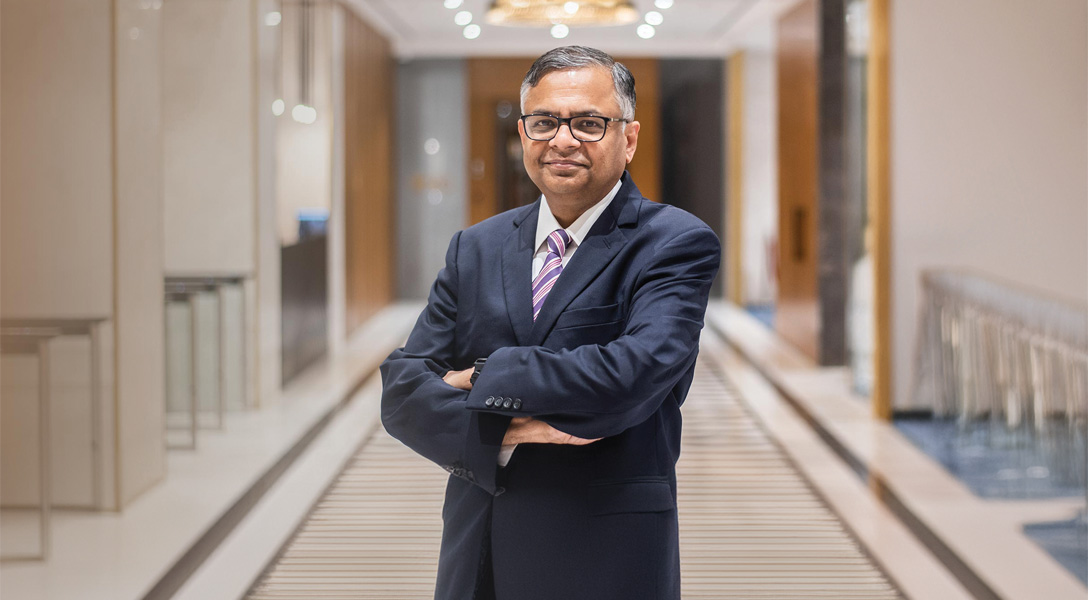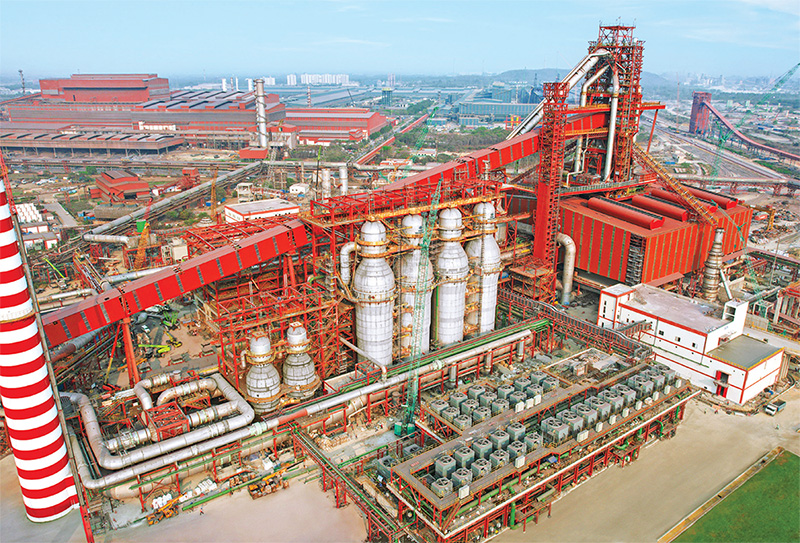Crafting a
bold future

N Chandrasekaran
Chairman

In FY2023-24, Tata Steel's Indian operations delivered the highest ever crude steel production at 20.8 MT and delivered the highest finished steel at 19.9 MT.
Dear Shareholders,
I hope this letter finds you and your families well.
The global economy, in CY2023, showed resilience despite geopolitical uncertainties, inflationary pressures, tighter monetary policies, sovereign debt concerns and sluggish trade. We expect infrastructure build, investments led by new technologies, and demographics of emerging markets to continue to drive global growth, estimated at 3.2% in CY2024, similar to CY2023.
The Indian economy maintained a steady momentum within the uneven global macro-economic landscape, supported by public spending on infrastructure and digitalisation, as well as reforms directed towards ease of doing business and incentivising new investment. In FY2023-24, the Indian GDP has grown at 8.2%, which is substantially higher than the global benchmark.
The steel industry fundamentals reflected these macro conditions, with geopolitical concerns and moderating demand in China resulting in pressure on steel prices, while input costs have remained relatively elevated and environmental and regulatory costs continue to rise. At the same time, the Indian market stood out as robust infrastructure spending, resurgence in private sector investment and robust demand meant that the industry saw crude steel production growth of 13% over the previous fiscal. We expect this trend to continue, with domestic steel demand remaining buoyant in FY2024-25 on the back of expansion in economic activity, while pricing conditions might see periods of pressure driven by global economic trends and policy changes.
In FY2023-24, Tata Steel's Indian operations delivered the highest ever crude steel production at 20.8 MT and delivered the highest finished steel at 19.9 MT. Tata Steel undertook successful trial of hydrogen injection in the E Blast Furnace at Jamshedpur. It was for the first time in the world that such a large quantity of hydrogen was continuously injected in a blast furnace.
Also, the Company encountered delays in large projects like the relining of Blast Furnace 6 in the Netherlands and Kalinganagar downstream. The insights gained from these delays will contribute to the smoother and more timely execution of ongoing projects.
As we expand operations, focus on safety becomes extremely important. We are dedicated to strengthening our processes and practices to achieve our goal of zero harm.
The Company also made significant progress towards simplification of its portfolio. The Company has successfully amalgamated five of its key entities in India.
Coming to the Company’s financial performance in FY2023-24, the consolidated revenues were at ₹2,29,171 crore compared to ₹2,43,353 crore in FY2022-23 and the consolidated EBITDA was ₹23,402 crore in FY2023-24 compared to ₹32,698 crore in FY2022-23. In FY2023-24, the Company’s consolidated net loss was ₹4,910 crore compared to a profit after tax of ₹8,075 crore in FY2022-23. The consolidated financial performance of the Company in FY2023-24 was impacted by weaker sales realisations, comparatively elevated raw material costs, a sharp fall in volumes at Tata Steel Nederland due to blast furnace relining, and high costs of operations on the back of declining reliability and productivity at the end-of-life heavyend assets in Tata Steel UK.
In FY2023-24, the standalone revenues were ₹1,40,987 crore compared to ₹1,42,913 crore in FY2022-23 and the standalone EBITDA was ₹31,004 crore in FY2023-24 compared to ₹28,754 crore in FY2022-23. In FY2023-24, the Company’s profit after tax was ₹4,807 crore compared to ₹14,685 crore in FY2022-23. Profit after tax was lower compared to the previous year primarily on account of an impairment charge of ₹12,560 crore taken in the standalone financial statements on account of the restructuring of the UK operations.
The Board of Directors has recommended a dividend of ₹3.60 per Ordinary (Equity) Share.
On the strategic front, the Company is making significant progress towards augmenting capacities in India to achieve its target of 40 MTPA capacity. The Company’s Kalinganagar Phase II expansion is in progress. The second blast furnace at Kalinganagar will be commissioned by September 2024, which will take the overall production capacity of hot metal to 8 MTPA at Tata Steel Kalinganagar, thereby expanding the flat products portfolio of the Company. The 0.75 MTPA scrapbased low-carbon electric arc furnace plant in Ludhiana, Punjab, India is also expected to be commissioned in early 2026 and will expand the long products portfolio of the Company.
The engineering work towards the phased expansion of the NINL plant from 1 MTPA to 5.5 MTPA is expected to begin later this fiscal
₹3.60
Dividend per Ordinary (Equity) Share recommended by the Board

The biggest greenfield blast furnace in the world, Tata Steel Kalinganagar
With respect to the UK operations, we have now identified and implemented a clear strategy for a sustainable, self-reliant, profitable business in the future that aligns with our global sustainability objectives. We will set up a state-of-the-art electric arc furnace in Port Talbot, targeted to be commissioned in 2027, which will reduce approximately 5 MT of direct CO2 emissions per annum, utilise locally available scrap and benefit from policies which will significantly benefit green steel production in the future. Ahead of the transition, we have decided that given the ageing end-oflife condition of several of the heavy end assets, we will carry out a phased closure of the two blast furnaces by September 2024, so as to eliminate losses in the ongoing operations. The proposed project would ensure continuity of steelmaking in Port Talbot after the transition, while also preserving a majority of jobs in Tata Steel UK.
We have commenced discussions with the Dutch government with regard to the decarbonisation strategy for Tata Steel Nederland. The decarbonisation of the business will be implemented in two phases with one blast furnace being replaced before 2030 and the second one thereafter.
4.4 Mn
Lives impacted through our CSR initiatives Care for community in FY2023-24

Care for community
For the first phase, we have outlined a plan to transition to green steel production by 2030 through the Direct Reduced Iron (DRI) and electric arc furnace route.
The DRI, set to initially operate on natural gas, will seamlessly transition to hydrogen when it emerges as an accessible and economically feasible energy source. We hope to conclude an agreement in this fiscal year.
Meanwhile, the Company continues to prioritise research and innovation initiatives, leverage technology and advancement in manufacturing, and tap into emerging markets to maintain its leadership. Additionally, it remains dedicated to promoting Diversity, Equity, and Inclusion, enhancing community engagements, and adopting sustainable business practices to ensure a resilient tomorrow.
The Company continues to engage with communities through its wideranging CSR programmes. During the year, the Company has positively impacted 4.4 million lives through its CSR programmes. The Company is committed towards improving the quality of lives of the communities in its areas of operation.
Before I conclude, I would like to convey my gratitude to Mr O P Bhatt who retired from the Board of the Company after serving for a decade. I also extend a warm welcome to Dr Shekhar Mande on the Board of the Company.
I thank all our employees for their commitment towards the Company. I also extend my deepest gratitude to all our stakeholders for their trust and confidence in us and hope to have their continued support in our journey towards a sustainable future.
Warm Regards,
N Chandrasekaran
Chairman